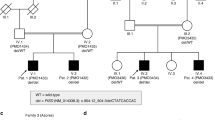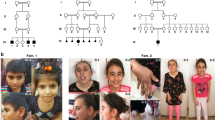Abstract
A candidate gene for Norrie disease, an X–linked disorder characterized by blindness, deafness and mental disturbances, was recently isolated and found to contain microdeletions in numerous patients. No strong homologies were identified. By studying the number and spacing of cysteine residues, we now detect homologies between the Norrie gene product and a C–terminal domain which is common to a group of proteins including mucins. Three newly–characterized missense mutations, replacing evolutionarily conserved cysteines or creating new cysteine codons, emphasize the functional importance of these sites. These findings and the clinical features of this disorder suggest a possible role for the Norrie gene in neuroectodermal cell–cell interaction.
This is a preview of subscription content, access via your institution
Access options
Subscribe to this journal
Receive 12 print issues and online access
$209.00 per year
only $17.42 per issue
Buy this article
- Purchase on Springer Link
- Instant access to full article PDF
Prices may be subject to local taxes which are calculated during checkout
Similar content being viewed by others
References
Norrie, G. Causes of blindness in children. Acta Ophtalmol. 5, 357–386 (1927).
Warburg, M. Norrie's disease: A new hereditary bilateral pseudotumor of the retina. Acta Ophtalmol. 39, 757–772 (1961).
Warburg, M. Norrie's disease: A congenital progressive oculo-acoustico-cerebral degeneration. Acta Ophtalmol. 89, 1–147 (1966).
Gal, A., Wieringa, B., Smeets, D.F.C.M., Bleeker-Wagemakers, L.M. & Ropers, H.-H. Submicroscopic interstitial deletion of the X-chromosome explains a complex genetic syndrome dominated by Norrie disease. Cytogenet. Cell Genet. 42, 219–224 (1986).
Donnai, D., Mountford, R.C. & Read, A.P. Norrie disease resulting from a gene deletion clinical features and DNA studies. J. med. Genet. 25, 73–78 (1988).
Sims, K.B. et al. The Norrie disease maps to a 150 kb region on chromosome Xp11.3. Hum. molec. Genet. 1, 83–89 (1992).
Berger, W. et al. Isolation of a candidate gene for Norrie disease by positional cloning. Nature Genet. 1, 199–203 (1992).
Chen, Z.-Y. et al. Isolation and characterization of a candidate gene for Norrie disease. Nature Genet. 1, 204–208 (1992).
Casanova, J.L., Pannetier, C., Javlin, C. & Kourilsky, P. Optimal conditions for directly sequencing double-stranded PCR products with sequenase. Nucl. Acids Res. 18, 4028 (1990).
Eckhardt, A.E., Timpte, C.S., Abernethy, J.L., Zhao, Y. & Hill, R.L. Porcine sub-maxillary mucin contains a cysteine-rich, carboxyl-terminal domain in addition to a highly repetitive, glycosylated domain. J. Biochem. 266, 9678–9686 (1991).
Probst, J.C., Gertzen, E.M. & Hoffmann, W. An integumentary mucin (FIM-B.1) from Xenopus laevis homologous with von Willebrand factor. Biochemistry 29, 6240–6244 (1990).
Breathnach, R. & Chambon, P. Organization and expression of eucaryotic split genes coding for proteins. Ann. Rev. Biochem. 50, 349–383 (1981).
Rupp, R.A.W. & Sippel, A.E. Chicken liver TGGCA protein purified by preparative mobility shift electrophoresis (PMSE) shows a 36.8 to 29.8 kd microheterogeneity. Nucl. Acids Res. 15, 9707–9726 (1987).
Gwo-Shu Lee, M., Lewis, S.A., Wilde, C.D. & Cowan, N.J. Evolutionary history of a multigene family an expressed human B-tubulin gene and three processed pseudogenes. Cell 33, 477–487 (1983).
Dudov, K.P. & Perry, R.P. The gene family encoding the mouse ribosomal protein L32 contains a uniquely expressed intron-containing gene and an unmutated processed gene. Cell 37, 457–468 (1984).
Kyte, J. & Doolittle, R.F. A simple method for displaying the hydropathic character of a protein. J. molec. Biol. 157, 105–132 (1986).
Pennica, D., Kohr, W.J., Kuang, W.-J., Glaister, D., Aggarwal, B.B., Chen, E.Y. & Goeddel, D.V. Identification of human uromodulin as the tamm horsfall urinary glycoprotein. Science 236, 83–88 (1987).
Pearson, W.R. & Lipman, D.J. Improved tools for biological sequence comparison. Proc. natn. Acad. Sci. U.S.A. 85, 2444–2448 (1988).
Argos, P. A sensitive procedure to compare amino acid sequences. J. molec. Biol. 193, 385–391 (1988).
Bhargava, A.K., Woitach, J.T., Davidson, E.A. & Bhavanadan, V.P. Cloning and cDNA sequence of a bovine submaxillary gland mucin-like protein containing two distinct domains. Proc. natn. Acad. Sci. U.S.A. 87, 6798–6802 (1990).
Rothberg, J.M., Jacobs, J.R., Goodman, C.S. & Artavanis-Tsakonas, S. Slit: an extracellular protein necessary for development of midline glia and commisural axon pathways contains both EGF and LRR domains. Genes Devl. 4, 2169–2187 (1990).
Titani, K. et al. Amino acid sequence of human von Willebrand factor. Biochemistry 25, 3171–3184 (1986).
Bonthron, D.T. et al. Structure of pre-pro-von Willebrand factor and its expression in heterologous cells. Nature 324, 270–273 (1986).
Simmons, D.L., Levy, D.B., Yannoni, Y. & Eriksson, R.L. Identification of a phorbol ester-repressible v-src inducible gene. Proc. natn. Acad. Sci. U.S.A. 86, 1178–1182 (1989).
O'Brien, T.P., Yang, G.P., Sanders, L. & Lau, L.F. Expression of cyr61, a growth factor-inducible immediate-early gene. Molec. Cell Biol. 10, 3569–3577 (1990).
Higgins, D.G. & Sharp, P.M. CLUSTAL a package for performing multiple sequence alignment on a microcomputer. Gene 73, 237–244 (1988).
Hunter, D.D., Shah, V., Merlie, J.P. & Sanes, J.R. A laminin-like adhesive protein concentrated in the synaptic cleft of the neuromuscular junction. Nature 338, 229–234 (1989).
Vasicek, T.J. et al. Nucleotide sequence of the human parathyroid hormone gene. Proc. natn. Acad. Sci. U.S.A. 80, 2127–2131 (1983).
Parkinson, D.B. & Thakker, R.V. A donor splice site mutation in the parathyroid hormone gene is associated with autosomal recessive hypoparathyroidism. Nature Genet. 1, 149–152 (1992).
Colby, W.W., Chen, E.Y., Smith, D.H. & Levinson, A.D. Identification and nucleotide sequence of a human locus homologous to the v-myc oncogene of avian myelocytomatosis virus. Nature 301, 722–725 (1983).
Battey, J. et al. The human c-myc oncogene structural consequences of translocation into the IgH locus in Burkitt lymphoma. Cell 34, 779–787 (1983).
Rouault, T.A., Hentze, M.W., Caughman, S.W., Harford, J.B. & Klausner, R.D. Binding of a cytosolic protein to the iron-responsive element of human ferritin messenger RNA. Science 241, 1207–1210 (1987).
Bird, A., Taggart, M., Frommer, M., Miller, O.J. & Macleod, D. A fraction ot the mouse genome that is derived from islands of nonmethylated, CpG-rich DNA. Cell 40, 91–100 (1985).
De Silva, D.G.H. & De Silva, D.B.K. Norrie's disease in an asian family. Brit. J. Ophthalmol. 72, 62–64 (1988).
Miller, S.A., Dykes, D.D. & Polesky, H.F. A simple salting out procedure for extracting DNA from human enucleated Cells. Nucl. Acids Res. 16, 1215 (1988).
Feinberg, A.P. & Vogelstein, B. A technique for radiolabeling DNA restriction endonuclease fragments to high specifity. Anal. Biochem. 137, 266–267 (1984).
Southern, E.M. Detection of specific sequences among DNA fragments separated by gel electrophoresis. J. Molec. Biol. 98, 503–517 (1975).
Sanger, F., Nicklen, S. & Coulson, A.R. DNA sequencing with chain-terminating inhibitors. Proc. natn. Acad. Sci. U.S.A. 74, 5463–5467 (1977).
Haltiner, M., Kempe, T. & Tijan, R. A novel strategy for constructing clustered point mutations. Nucl. Acids Res. 13, 1015–1025 (1985).
Saiki, R.K. et al. Primer directed enzymatic amplification of DNA with a thermostable DNA polymerase. Science 239, 487–491 (1988).
Author information
Authors and Affiliations
Rights and permissions
About this article
Cite this article
Meindl, A., Berger, W., Meitinger, T. et al. Norrie disease is caused by mutations in an extracellular protein resembling C–terminal globular domain of mucins. Nat Genet 2, 139–143 (1992). https://doi.org/10.1038/ng1092-139
Received:
Accepted:
Issue Date:
DOI: https://doi.org/10.1038/ng1092-139
This article is cited by
-
Retinoschisis and Norrie disease: a missing link
BMC Research Notes (2021)
-
Clinical and genetic analysis of Indian patients with NDP-related retinopathies
International Ophthalmology (2018)
-
Familial exudative vitreoretinopathy and related retinopathies
Eye (2015)
-
Familial cases of Norrie disease detected by copy number analysis
Japanese Journal of Ophthalmology (2014)



